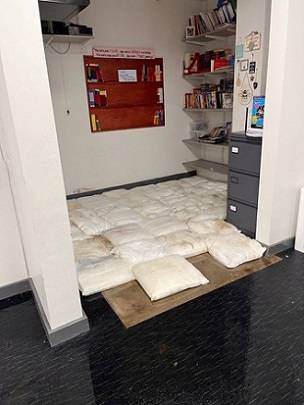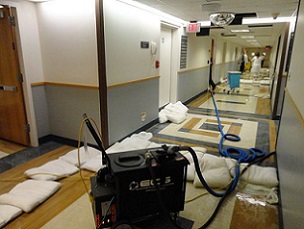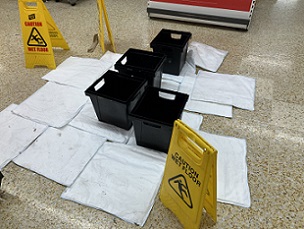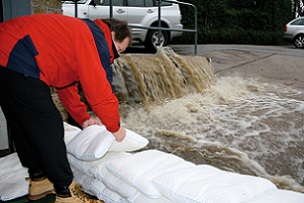 FloodSax alternative sandbags soaking up floodwater at a school in Huddersfield, West Yorkshire
FloodSax alternative sandbags soaking up floodwater at a school in Huddersfield, West Yorkshire
 FloodSax deployed during a flood at a hospital
FloodSax deployed during a flood at a hospital
 FloodSax sandless sandbags being used to soak up water from a leaking roof in a supermarket
FloodSax sandless sandbags being used to soak up water from a leaking roof in a supermarket
 FloodSax built into a temporary flood protection barrier to stop torrential floodwater
FloodSax built into a temporary flood protection barrier to stop torrential floodwater
Schools, hospitals and care homes must be prepared for flooding says Environment Agency
All schools, hospitals and care homes need to be prepared for the risk of flooding, according to the Environment Agency.
Water can cause danger and serious damage in minutes and this can be from escapes of water inside buildings from burst pipes or taps simply left running to rainwater pouring in through leaky roofs or flowing in through doors.
Some schools, hospitals and care homes are even in danger from flooding from streams and rivers or face problems with water pouring off nearby hills during torrential downpours. The average business flood claim in the UK is £70,000 according to figures from the Association of British Insurers.
It’s not sure how many schools, hospitals and care homes across the UK have a flood action plan but the Environment Agency says all of them should in a publication called Flooding: Minimising The Risks.
The Environment Agency warns: “Floods can happen anywhere at any time. They’re caused by rising ground water levels, burst water drains, rainwater running off hillsides as well as flooding from rivers and the sea. Even if you live miles away from the coast or a river there’s still a chance flooding could affect you.
“With careful planning you can take action to help reduce the impact of flooding, for example creating sandbag walls or temporary defence systems. There are lots of things you can do to reduce flood damage.”
Sandbags are very hard to store, difficult to deploy and often deteriorate and rip when they come into contact with floodwater which is why many schools, hospitals and care homes now use FloodSax alternative sandbags.
Several hospital trusts and one of the biggest care home companies in the UK use them as they are space-saving to store, quick and easy to deploy and are multi-purpose and flexible so can be used outside or inside.
They are also part of a package of anti-flood measures sent out to schools nationwide.
In their dry state FloodSax have a large surface area yet are very thin so can soak up water from internal floods, especially in hard-to-reach places such as underneath sinks, beneath floorboards or below radiators.
Yet immerse them fully in water and the gelling polymer inside absorbs up to 20 litres and retains it, turning them into instant sandbags but without any sand which means they can be built into temporary flood barriers.
They are largely biodegradable by weight so are more environmentally friendly and more effective than traditional sandbags as they are bigger with a more uniform shape so easier to build into temporary flood barriers.
One junior school will never use sandbags again after discovering FloodSax alternative sandbags during a flooding emergency.
Water began to flood into a classroom at Marsden Junior School in Huddersfield, West Yorkshire, with the problem caused by water cascading down a nearby hillside during torrential rain.
The flood seeped across the classroom floor, totally soaking the carpet.
The FloodSax were used to soak up the water and then to build a small temporary barrier in the corner of the classroom where the water was coming in. The FloodSax contained the water which became deep enough to be then pumped out.
The school’s business manager, Cath O’Connor, said: “We’ll never use sandbags again as the FloodSax have been so flexible and multi-functional, both at soaking up the water and then as alternative sandless sandbags.”
Some have been stacked against the wall in the boiler house to try to stop the water getting through again if it rains heavily.
FloodSax are also used by supermarkets to slip under leaky refrigeration units or to soak up water on the floor which has become a health and safety slip hazard.
One of the big five supermarkets uses them nationwide to protect its stores and facilities management companies across the UK are realising that FloodSax are a way better alternative to old-style sandbags.
For more on FloodSax go to www.floodsax.co.uk